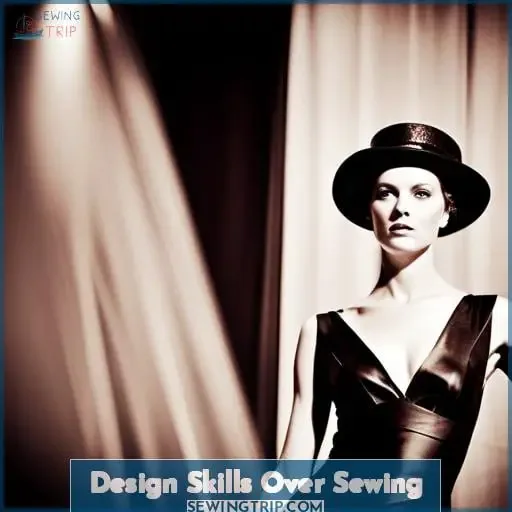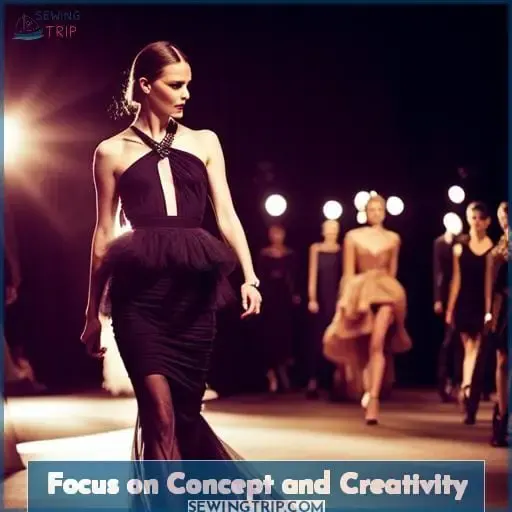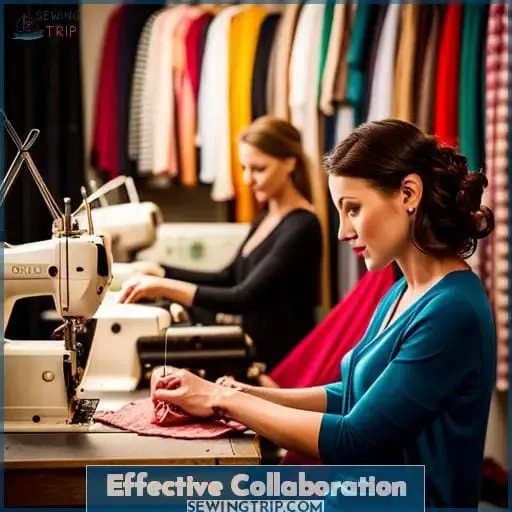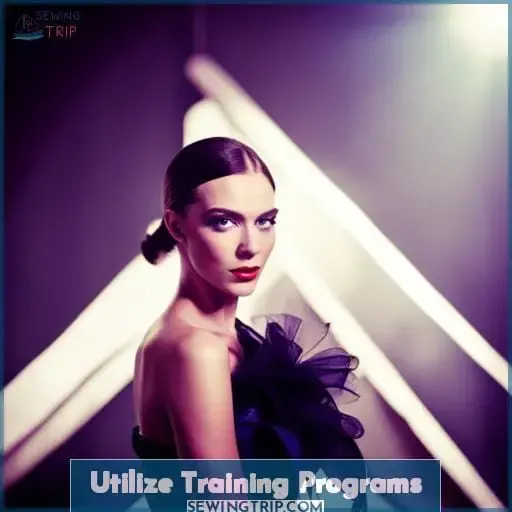This site is supported by our readers. We may earn a commission, at no cost to you, if you purchase through links.
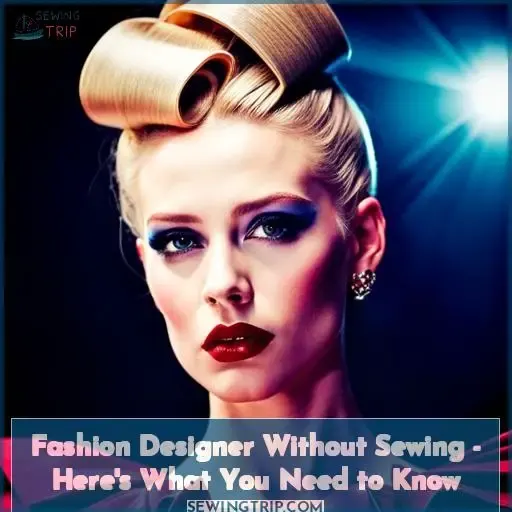 Looking in the mirror, you see a glamorous fashionista staring back. Sketchpad in hand, you dream up dazzling designs. But can you make it in this industry without knowing how to sew? Absolutely! Creativity and collaboration are the real keys.
Looking in the mirror, you see a glamorous fashionista staring back. Sketchpad in hand, you dream up dazzling designs. But can you make it in this industry without knowing how to sew? Absolutely! Creativity and collaboration are the real keys.
So grab your imagination, team up with talented tailors, and unleash those visionary ideas.
Table Of Contents
Key Takeaways
- Fashion designers can s쳮d without sewing skills. Focus instead on sketching and conveying design ideas.
- Master fashion design software, CAD programs, and other technology tools to bring designs to life.
- Effective collaboration with patternmakers, fabric suppliers, and manufacturers is vital for translating designs into finished products.
- Build relationships and connect with fashion industry partners through networking and mentorships.
Design Skills Over Sewing
You can focus on your creativity and design vision without getting bogged down in the sewing details. As a fashion designer, the most important thing is your creative expertise and ability to bring imaginative ideas to life.
Leave the sewing and construction to skilled patternmakers and sample hands. Instead, devote your energy to sketching original designs, gathering fabric and color inspiration, and conveying the visual details that make your creative vision stand out.
Collaboration is key – work closely with patternmakers, fabric suppliers, and manufacturers to translate your designs from concept to finished product. While basic sewing skills can be useful, they aren’t mandatory for successful fashion designers today.
With all the technological tools available, like fashion design software and digital CAD, you can focus on honing your creative talents and design skills over learning to sew.
Your passion and creative vision are what really matters in making innovative fashion.
Focus on Concept and Creativity
You’re so right, a designer’s skills go far beyond just sewing. Your true talent lies in having a creative vision and bringing conceptual fashion to life. Don’t worry if you can’t sew a stitch – that’s not what matters most. What’s crucial is your ability to freely channel artistic inspiration into innovative designs.
Let your passion for fashion guide you as you seek new sources of design inspiration. Immerse yourself in the vision you have for transforming raw materials into beautiful garments. Stay focused on bringing your creative expression to the forefront. Conceptualization is the heart of the design process.
Master communicating your vision in sketches and samples. Collaborate with those who can execute the physical construction.
You have a gift for envisioning fashion’s future – now believe in your power to manifest those dreams through creative partnerships.
Effective Collaboration
Designing fashion without sewing skills requires effective collaboration. To bring creative visions to life through quality construction, partnering with talented patternmakers and factories is essential.
While a designer’s imagination fuels the creative process, expertise in patternmaking and manufacturing transforms imaginative concepts into wearable garments. By building collaborative relationships, fashion designers without sewing proficiency can see their artistic apparel ideas fully realized.
Patternmakers
Collaboration with talented patternmakers is crucial for bringing creative fashion designs to life. As a designer, lean on their technical expertise to translate your vision into producible patterns. Through respectful teamwork, patternmakers can elevate your concepts, considering real-world construction challenges.
Their skills complement yours. Value their role in manifesting garments. Though your hand may not guide the patternmaking, your spirit steers the collaboration.
Factories
Openness to feedback from factories is vital for developing designs that translate into quality garments. Successful partnerships with factories involve collaborations where designers understand manufacturing processes.
Connecting with factories that produce your designs is part of the fashion design process. Industry connections allow you to learn about essential clothing production partnerships for bringing fashion ideas to retail.
Focus on building relationships with fashion factories, as the most successful fashion designers master both design concepts and manufacturing realities.
Consider Other Fashion Careers
Hello fashionista! To s쳮d as a fashion designer without sewing skills, focus first on honing your creativity, design vision, and ability to communicate ideas clearly. Effective collaboration with patternmakers and factory partners is also essential to bring your visions to life in wearable garments.
Essential Design Skills
Possessing strong sketching abilities allows visualizing designs without sewing. To excel as a fashion designer without stitching, honing drawing skills proves paramount for conveying creative visions.
Master essential terminology and construction to direct garment creation. While collaborators handle construction, your flair for style and design must shine through professional illustrations. Formal education refines raw talent into refined techniques for realizing your fashion aspirations.
– Effective Collaboration
You’d better have an open mind when working with your patternmakers and factory partners. Collaborative success depends on team communication between designers and patternmakers. Build positive factory partnerships through respectful production collaboration with the skilled professionals who bring your visions to life.
– Marketing and Branding
Brand exposure helps get your name out there. For example, promoting your designs on Instagram to reach potential customers can increase sales. Building your brand identity through social media marketing and fashion photography allows you to connect with your target market.
Seeking mentorship benefits your marketing strategies and online presence. Curating a fashion portfolio that reflects your identity can help you find success in fashion design.
Utilize Training Programs
Enrolling in a program like ‘Fashion Design Success’ can provide the in-depth knowledge and mentoring needed to excel as a fashion designer without sewing skills. A comprehensive training program arms you with the tools to refine your creative vision and effectively communicate designs.
Through practical exercises and mentor guidance, you’ll enhance drawing abilities, learn design communication, gain insight into trends, and understand marketing essentials.
These learning opportunities aid in honing skills critical for fashion designers like conveying design intent, selecting fabrics, and building a brand identity. While sewing skills aren’t mandatory, the knowledge gained will prime you for collaborating with pattern makers and factories to manifest creations.
With new capabilities and confidence, you’ll be equipped to impress at fashion events, network with industry contacts, and ultimately achieve fashion goals. The investment in focused training and mentorship can unlock doors in fashion design without traditional sewing skills.
Conclusion
As a flower blooms in spring, so can your fashion career blossom without traditional sewing skills. Your passion, vision, and perseverance will enable you to thrive as a designer. Effective collaboration, marketing savvy, and a unique creative voice are the keys to success.
With the right skills and attitude, you can absolutely s쳮d as a fashion designer without sewing. Focus on your concept and creativity, then partner with talented collaborators to bring your designs to life.

